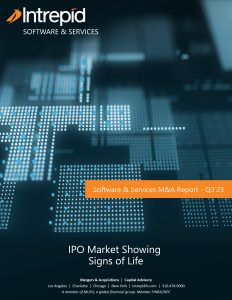In the words of Mark Twain, “Reports of my death have been greatly exaggerated.” After a year-long slump in the IPO market, a string of recent offerings has provided us with cautious optimism around the issuance market in 2024. How real is it? And what might it indicate for the broader deal-making environment?
The past quarter has been marked by several high-profile technology IPOs, including that of microchip designer Arm, marketing automation software provider Klaviyo, and online grocery delivery service Instacart. These recent public offerings may have marked the turning point in an IPO market that had been near historic lows – a particularly somber fact after the near-record highs of 2021. For reference, over the past twenty years, there have been an average of 255 US-based IPOs per year, representing $59.5 billion raised per year. With investors willing to take riskier bets in 2021 when valuations were high and debt was cheap, those figures were 908 IPOs, raising $276.3 billion of capital. YTD 2023, we have seen just 75 IPOs raising $14.6 billion through Q3, over a 90% decline in volume and value.
The decline in the IPO market can be attributed to a combination of the drop in public valuations, a spike in inflation, and increased interest rates. A warm-up is welcome and gives us hope that a broader uptick in the deal environment may be forthcoming. To be candid, though, the revival is still early and many private investors have in fact seen negative returns. Look no further than Instacart, whose $10.0 billion IPO is a far cry from its $39.0 billion valuation in March 2021. Some issues have also declined after their debuts. Obviously, our enthusiasm should be tempered.
Still, with valuations well below 2021 highs, inflation still a concern, and debt expensive, why are the likes of Arm, Klaviyo, and Instacart going public now? It’s all about perspective. While recessionary fears remain, the US economy has largely defied expectations to date. The S&P 500 is up nearly 12% since the beginning of the year, while the tech-heavy Nasdaq is up an impressive 26%. Meanwhile, inflation has moderated to 3.7% in August, albeit still above the Fed’s 2.0% target, and analysts expect Fed interest rate hikes to be nearing an end. So, while we’re past the unsustainable highs of 2021, there’s a newfound optimism we may have dodged the worst of a “hard landing”. This reshaped perspective is creating a willingness from investors to dive in and test the IPO waters, given the substantial backlog of investments that, economic cycle aside, would have already gone public. By Pitchbook’s estimates, there is a backlog of 77 IPO ready, US-based companies. Despite this backlog, the IPO resurgence is likely to be a steady and gradual progression. Nevertheless, we see momentum building and find it encouraging for capital markets as a whole.
But what are the implications for the broader private deal market? To start, the M&A market has historically been correlated with the public equities market. Digging a bit deeper, we believe the improved investor confidence enabling the IPO recovery will carry over into the private markets and directly align with the perspective and feedback discussed in our recent conversations. After all, private investors frequently turn to the public markets for indications of value. Additionally, the recent string of IPOs demonstrate the importance of profitability for tech companies seeking premium valuations as opposed to the cash-burning, growth-at-all-cost days. We at Intrepid have observed the growing investor focus on profitability in the private market, particularly for deals financed with a debt component. For founders exploring capital advisory, strategic options or just looking to discuss the market, we would be happy to have a discussion!


